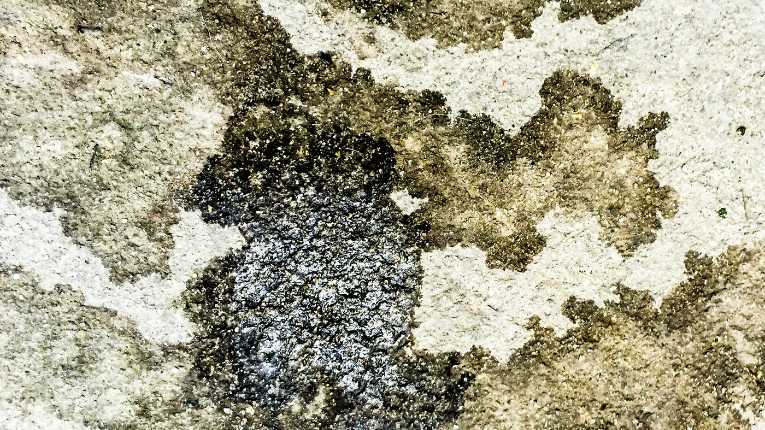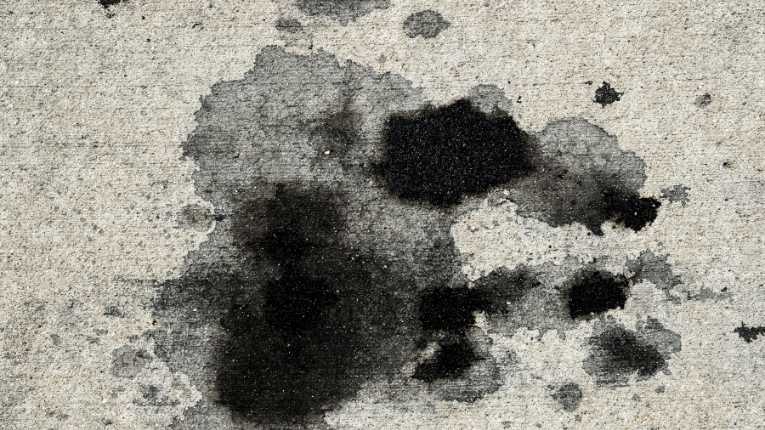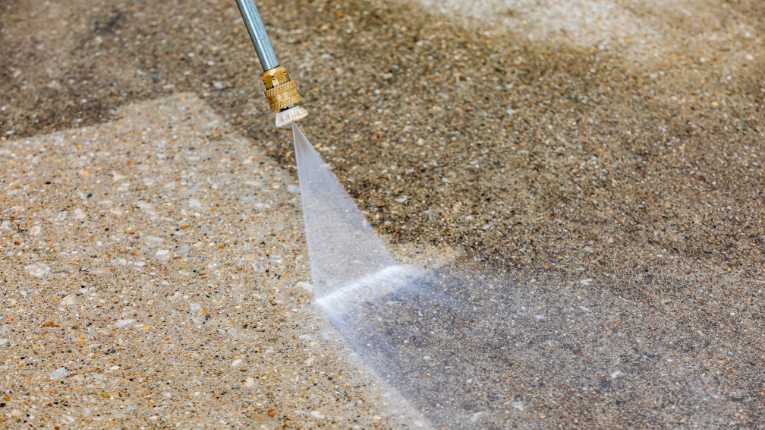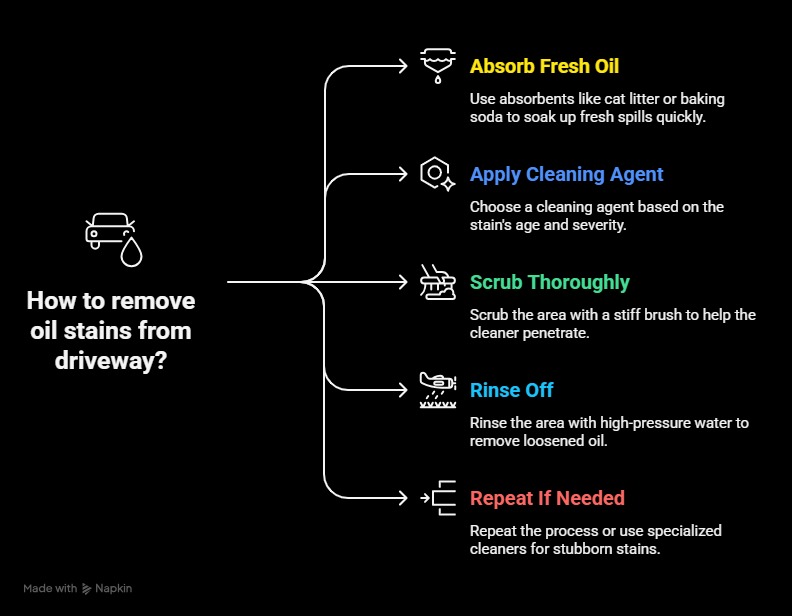How to Remove Oil Stains From Your Concrete Driveway Easily

Say Goodbye to Stubborn Oil Stains on Your Driveway
A driveway with oil stains is more than just an eyesore. Over time, they may reduce the curb appeal of your house and even lower its value. Ignoring the issue only makes it more difficult to fix, whether it's a recent spill or an old stain that has become embedded deeply in the concrete.
Oil removal from concrete gets more difficult the longer you wait. If oil stains on a driveway are not removed, they may become irreversible. To assist you in removing oil stains from concrete, we have developed this simple guide.
Understanding Oil Stains on Driveways

Types of Oil Stains: Fresh vs. Old
- Fresh Oil Stains: These spills are recent and haven’t yet caused significant damage to the concrete. If taken care of right away, they are usually simpler to clean.
- Old Oil Stains: As oil penetrates the pores of the concrete more deeply over time, these stains become more difficult to get rid of.
Addressing stains promptly can prevent them from becoming permanent fixtures on your driveway.
How Oil Interacts with Concrete
- Initial Absorption: The oil begins to seep into the surface almost immediately.
- Deep Penetration: Without prompt cleaning, the oil continues to penetrate deeper, making it harder to remove.
- Chemical Bonding: Over time, the oil can bond with the concrete, leading to discoloration and weakening of the material.
This absorption process underscores the importance of immediate action when oil spills occur.
Challenges in Removing Oil Stains from Concrete
- Porosity of Concrete: Its absorbent nature means oil can penetrate deeply, making surface cleaning insufficient.
- Chemical Composition of Oil: Oil contains complex hydrocarbons that can bind tightly to concrete particles.
- Time Factor: The longer a stain remains untreated, the more it sets, requiring more aggressive cleaning methods.
- Environmental Concerns: Some cleaning agents can harm the environment, necessitating careful selection of eco-friendly products.
Understanding these challenges can help in selecting the most effective and safe cleaning methods.
Preparation Before Cleaning Oil Stains from a Driveway

Before you jump into cleaning oil stains on your driveway, it’s important to take a few key steps to stay safe and get better results.
Stay Safe First
- Wear gloves to keep oil and cleaning chemicals off your skin
- Use safety goggles to protect your eyes from splashes
- Work in a well-ventilated area, especially if you're using strong cleaners like commercial degreasers or mineral spirits
When attempting to remove oil from driveway surfaces on your own, safety is just as crucial as it is for experts.
Gather the Right Tools and Materials
- Absorbents like kitty litter, baking soda, or sawdust for soaking up fresh oil
- Stiff brush or broom for scrubbing
- Degreasing agents or driveway cleaner for breaking down oil
- Pressure washer or hose for rinsing off residue
- Plastic scraper or putty knife for thick buildup
- Old towels or rags for blotting and drying
Having all your tools in one place helps you remove oil from concrete quickly before it sets deeper into the surface.
Check the Stain Type and Severity
- A new stain? It will appear dark and damp. Start with absorbents; these are much easier to lift.
- Stain that has set in? Older or dry stains may have seeped deeper into the concrete and frequently turn brown or black. More work and stronger cleaners will be required for these.
- Is it a motor oil stain or something else? Grease, cooking oil, or transmission fluid can require slightly different treatments.
Take a good look at the affected area before starting. This helps you choose the right cleaner and method, saving time, effort, and frustration.
Step-by-Step Guide to Removing Oil Stains from Your Driveway

Removing oil stains from your driveway doesn’t have to be difficult. The correct actions can make all the difference, whether the stain is old and set in or the spill was recent. Use this easy method to remove oil from driveway surfaces without causing any damage to your concrete.
1. Absorb Fresh Oil Spills Quickly
- Sprinkle cat litter, baking soda, or sawdust directly on the stain. These absorbents pull oil out of the surface.
- Let it sit for at least 2–3 hours, or overnight for better results.
- Use a stiff broom to sweep it up. You want to soak up as much oil as you can first, so don’t use water at this point.
This step is especially helpful for those learning how to get rid of oil stains on driveway areas before they set in.
2. Apply a Cleaning Agent Based on the Stain
- For light or recent stains, mix dish soap with warm water. Dish soap breaks down grease effectively.
- For tougher or older stains, use a commercial degreaser designed to remove oil from driveway surfaces. Always follow the instructions on the label.
- Prefer natural options? Make a paste of baking soda and water, or use vinegar. These work best on newer stains and are less harsh on the environment.
Choosing the right cleaner is key to removing oil stains from driveway concrete without causing damage.
3. Scrub the Stain Thoroughly
- Use a stiff-bristled brush (not metal) to scrub the area. This helps the cleaner work deeper into the concrete’s pores.
- Let the solution sit for 15–30 minutes after scrubbing. This gives it time to break down the oil properly.
This step is essential, especially if you’re trying to figure out how to get oil stains off concrete after they’ve had time to dry and harden.
4. Rinse Everything Off Thoroughly
- Rinse the area with a garden hose using high pressure, or better yet, use a pressure washer if you have one.
- Check the results. If the stain is still visible, don’t worry, some oil marks on driveway surfaces take more than one round.
This rinse helps lift the loosened oil from the concrete so it doesn’t resettle.
5. Repeat If Needed
- Be patient. You might need to repeat the cleaning process once or twice, especially to remove old oil stains from the driveway.
- For stubborn stains that won’t lift, consider using specialized oil stain removers or concrete poultice cleaners available at hardware stores.
Persistence is key when figuring out how to get oil stains out of driveway concrete, especially when the stains have been sitting for weeks or months.
Alternative Methods for Stubborn Oil Stains on Driveway
Scrubbing and ordinary soap are insufficient to remove certain oil stains. It’s time to investigate more sophisticated techniques if you’ve already tried the fundamentals and the stain is still present. These three tried-and-true substitutes are particularly effective at removing deep-set or older oil stains from driveway surfaces.
1. Use a Poultice for Deep-Set Stains
- A poultice is a thick paste made by mixing an absorbent material (like baking soda, diatomaceous earth, or powdered laundry detergent) with a strong cleaner or degreaser.
- Spread the paste over the stain, then cover it with plastic wrap and tape down the edges.
- Let it sit for 24–48 hours. As it dries, the mixture draws the oil out of the concrete.
- Scrape it off, rinse thoroughly, and repeat if needed.
This method is rarely mentioned in detail by competitors, but it’s incredibly effective for people trying to figure out how to get oil stains out of driveway surfaces that have aged or penetrated deeply.
2. Try Enzyme-Based or Eco-Friendly Cleaners
- These cleaners work by breaking down oil molecules naturally using enzymes or microbes.
- They’re safe for kids, pets, and your landscaping—ideal for regular use.
- Although they may take longer to work than chemical degreasers, they’re a smart choice for light-to-moderate oil stains or for people who want to remove oil stains from driveway without using harmful products.
Most competitors mention dish soap or degreasers, but they rarely emphasize this cleaner type, giving you an edge by offering safer alternatives.
3. Consider Professional Cleaning Services
- Professional services use industrial-grade degreasers and pressure washers that clean deeper than DIY options.
- Some companies even use steam cleaning or hot water extraction to lift oil marks on driveway surfaces.
- If you’re dealing with years of buildup or a large oil spill, this is often the most time-efficient and effective solution.
Many homeowners choose not to use this option because of the expense, but in severe situations, it can save time and frustration, particularly if you’re having trouble getting rid of stubborn oil stains on driveway concrete.
Preventing Future Oil Stains on Your Driveway
The best way to maintain the cleanliness of your driveway after learning how to remove oil stains from concrete is to avoid getting new stains. You can save time and effort later on by following a few easy steps.
1. Regular Maintenance and Sealing
- Sealing your driveway creates a protective barrier that reduces the concrete’s porosity, making it harder for oil and other liquids to soak in.
- Regular maintenance, including cleaning and resealing every few years, can keep your surface resilient against stains and weather damage.
- Many homeowners don’t realize that sealing concrete is a key step to making cleaning oil off driveway surfaces much easier.
2. Promptly Address Vehicle Leaks
- Keep an eye on your vehicles for any leaks and get them fixed quickly.
- The longer oil sits on concrete, the deeper it penetrates, making removing oil stains from the driveway much tougher.
- Regularly check under your car or truck for fresh drips, especially if you park in the same spot every day.
3. Use Drip Pans or Mats Under Vehicles
- These mats catch oil drips before they touch your driveway, protecting your concrete surface.
- They’re inexpensive and easy to use, and you can find options designed specifically for garages and driveways.
- This preventative step helps reduce the need for aggressive cleaning methods later on, saving you the hassle of trying to get oil stains off driveway concrete.
Finishing: Keep Your Driveway Clean and Protected
The secret to avoiding irreversible damage is to remove oil stains from your driveway as soon as possible. Maintaining the aesthetic appeal of your concrete greatly depends on timely and appropriate cleaning, regardless of whether you’re dealing with recent spills or enduring old stains.
Frequent upkeep prolongs the life of your driveway and helps maintain its appearance. This includes sealing your driveway and promptly addressing any leaks or drips. By lowering the need for difficult stain removal later on, a well-maintained driveway not only looks better but also saves you time and money.
We would be delighted to hear from you! Please feel free to leave a comment if you have any advice or firsthand knowledge on how to get rid of oil stains from driveway concrete. Others may find your tips useful in maintaining the cleanliness of their driveways and
Frequently Asked Questions
For fresh spills, absorb excess oil with cat litter or baking soda, then scrub with dish soap and warm water. For tougher stains, use commercial degreasers or natural alternatives like a baking soda paste.
Yes, dish soap, baking soda, and vinegar are effective for light stains. However, deep or old stains may require specialized cleaning agents or professional help.
Sealing every 2 to 3 years is recommended. This helps protect your concrete and makes cleaning oil stains easier.
Yes, but old stains often need multiple treatments or stronger cleaning products, such as poultices or enzyme-based cleaners.
For extensive or stubborn oil stains, professionals have the tools and expertise to restore your driveway effectively, saving you time and effort.

